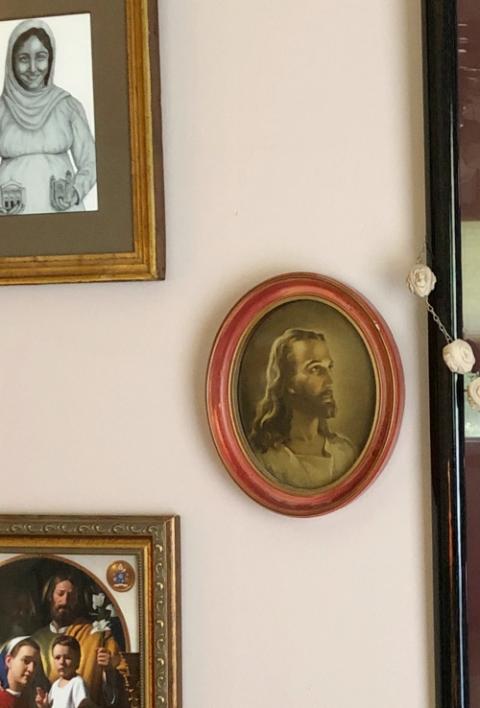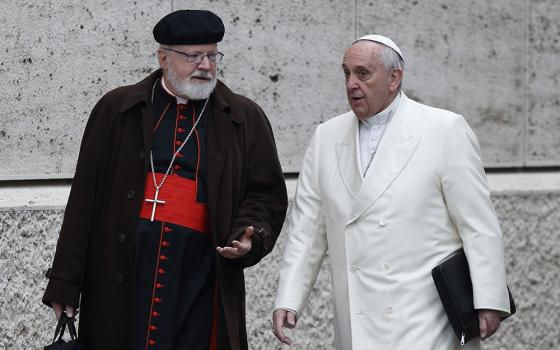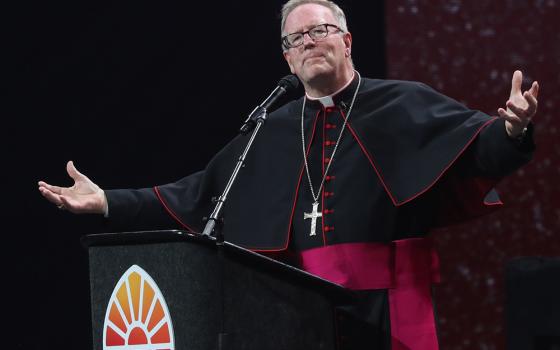
Detail from "Jesus of the People" by Janet McKenzie, winner of National Catholic Reporter's Jesus 2000 art contest in 1999
Most of us have seen the images by now.
Protesters gathering in parks and public spaces across the country, ropes and pulleys in hand, intent on bringing down statues of Confederate generals, former presidents and even saints with questionable histories of racism or outright white supremacy.
Will they be coming to churches next?
Shaun King, a writer-in-residence at Harvard Law School's Fair Punishment Project, activist and social media provocateur, tweeted a suggestion June 22 that statues of the "white European they claim is Jesus" should be taken down from houses of worship across the country.
"All murals and stained glass windows of white Jesus, and his European mother, and their white friends should also come down," King added later.

A 1950s-era framed print of Warner Sallman’s “Head of Christ” is seen among other religious art on the wall of a Catholic home. (Diane Ortiz)
While we certainly do not condone violence against church property, King and the thousands who agreed in replies to his feed have a point. As a Palestinian Jew, Jesus was not white, and the ubiquitous depiction of Jesus as not only white, but often blonde-haired and blue-eyed as in the famous Warner Sallman illustration "Head of Christ," is not without consequences, both theological and psychological.
An exclusively white Jesus not only narrows our understanding of him, it sends a message that connects Jesus to the powerful, not the oppressed.
"If Jesus is white and God is white, then authority is white," Anthea Butler, an associate professor of religious studies and Africana studies at the University of Pennsylvania, told Religion News Service.
One of the uniquenesses of the Catholic experience is the way Jesus, Mary and many of the saints are represented differently in societies across the globe. A walk through the more than 80 chapels in Washington's Basilica of the National Shrine of the Immaculate Conception shows the Holy Family with a multitude of faces.
A highlight is its "Our Mother of Africa" chapel, which includes striking Black depictions of the faces of the Gospel writers and a crucified Jesus made out of ebony, carved by a Tanzanian sculptor.
But how many of us think of these faces in our daily prayer lives? How many of us are confronted with the image of Jesus in a Black body at our parishes? How many of us are uncomfortable with the fact that God chose to become incarnate in a body that was not white, but likely brown?
Advertisement
Twenty years ago, NCR celebrated the new millennium with an art contest to answer the question: "What would Jesus Christ look like in the year 2000?" Janet McKenzie's winning image depicted the savior as a Black person who, in the words of judge Sr. Wendy Beckett, was "dark, thick-lipped, looking out on us with ineffable dignity, with sadness but with confidence."
Perhaps art contests are a place to start. Dioceses could host them, offering the winning images pride of place in their cathedrals. Better yet, they could suggest that their parishes try to replace at least one white version of Jesus and Mary with depictions of people of color.
Symbols matter, of course. And the versions of Jesus that white U.S. Catholics see in their parishes will surely influence how they look at their non-white neighbors and whether those white Catholics will stand up to oppose sinful structures of racism.
"To love another person is to see the face of God," Jean Valjean sings in the musical "Les Misérables." There are at least as many faces of God as there are people on Earth. Our churches should depict the multitude.




